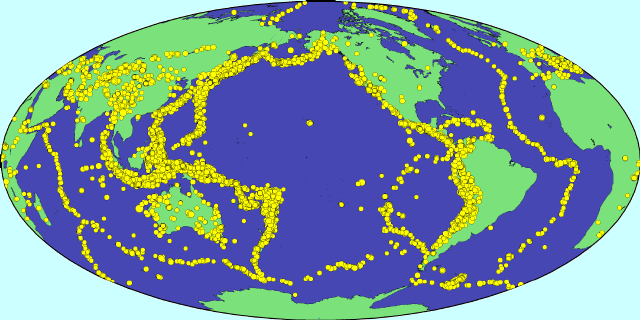Seismo Blog
Where Earthquakes Occur
Categories: Global Seismicity | Plate Tectonics
September 29, 2008

Earthquakes occur everywhere - so, at least, it seems. Temblors happen on all continents and beneath the deep oceans. They shake the world's highest mountains, the Himalayas, and the Earth's deepest valley, the Dead Sea. Even from under the ice caps of both polar regions, seismometers regularly record rumblings in the Earth's crust. But a more detailed look reveals that the distribution of earthquake foci in the world is by no means random. And neither are they evenly or regularly spaced. Instead, when plotted on a world map, earthquake locations look like narrow bands winding through the continents and oceans (see map). What are these zones and why are most earthquakes foci concentrated there?
Simply put, temblors happen when rock breaks under force. Inside the Earth, the most important of such rock crushing forces is the "tectonic stress." It is exerted on the Earth's crust by the movement of the giant, rigid plates, which float on a subterreanean sea of hot and plastic rock called the asthenosphere. There are about twelve huge and another dozen smaller plates. Where ever such plates crush into or slide past each other during their respective drifts on the Earth's surface, the collision is able to break the rock, thus causing earthquakes. In principle, the effects of such plate collisions are similar to a car wreck where two automobiles hit each other, albeit on a much larger scale.
The bands of earthquake foci in the map reflect these collision zones of the tectonic plates. In fact, they very clearly mark the boundaries of the plates. Look for instance at North America. The underlying plate is much bigger than the continent itself. It stretches from Iceland in the East all the way to the most far flung Aleutian islands in the West and reaches from Alaska to the Caribbean and beyond to the Azores, the island archipelago in middle of the Atlantic Ocean.
But earthquakes happen not only where plates collide. They also occur where two plates move away from each other in the so called "spreading zones." One of these zones is the Mid-Atlantic Ridge where Europe moves away from North America at the rate of about one inch per year. You will find such ridges in every major ocean basin. In fact, there are many more miles of plate boundaries under the oceans than on land. As a consequence, the number of submarine earthquakes is also larger than the number of quakes on land. (hra006)
BSL Blogging Team: Who we are
Recent Posts
-
: Alerts for the Whole West Coast
-
: Destruction in the Eastern Aegean Sea
-
: An Explosion in Beirut heard all over the Middle East
View Posts By Location
Categories
- Alaska (3)
- Bay Area (24)
- Buildings (3)
- Calaveras (4)
- California (13)
- Central California (4)
- Chile (4)
- Earthquake Early Warning (10)
- Earthquake Faults and Faulting (44)
- Earthquake Science (3)
- Haiti (3)
- Hayward (12)
- Indonesia (4)
- Induced Seismicity (3)
- Instrumentation (18)
- Italy (6)
- Japan (7)
- MOBB (3)
- Mendocino Triple Junction (5)
- Mexico (7)
- Nepal (3)
- North Korea (5)
- Nuclear Test (5)
- Ocean Bottom Seismometer (3)
- Oklahoma (4)
- Plate Tectonics (18)
- Preparedness, Risks, and Hazards (15)
- Salton Sea (3)
- San Andreas Fault (14)
- Seismic Waves (13)
- Seismograms (4)
- ShakeAlert (3)
- Southern California (5)
- Surface Waves (3)
- Today in Earthquake History (20)
- Volcanoes (4)
- subduction (3)